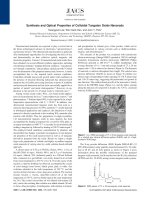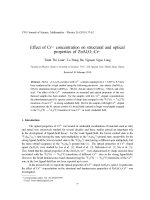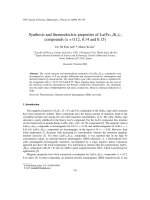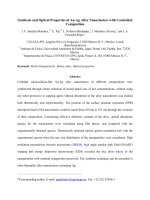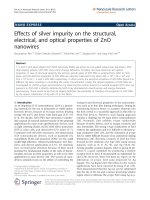Synthesis and Optical Properties of Ho 3+ , Pr 3+ Co-doped LaF3 Nanocrystals
Bạn đang xem bản rút gọn của tài liệu. Xem và tải ngay bản đầy đủ của tài liệu tại đây (662.79 KB, 6 trang )
<span class='text_page_counter'>(1)</span><div class='page_container' data-page=1>
26
Synthesis and Optical Properties of Ho
3+, Pr
3+Co-doped
LaF
<sub>3</sub>Nanocrystals
Hoang Manh Ha
1,2,*, Tran Thi Quynh Hoa
1,3, Le Van Vu
1, Nguyen Ngoc Long
1<i>1</i>
<i>Center for Materials Science, Faculty of Physics, VNU University of Science, </i>
<i>334 Nguyen Trai, Thanh Xuan, Hanoi, Vietnam </i>
<i>2</i>
<i>Hanoi Architectural University, Km 10 Nguyen Trai, Thanh Xuan, Hanoi, Vietnam </i>
<i>3 </i>
<i>National University of Civil Engineering, 55 Giai Phong, Hai Ba Trung, Hanoi, Vietnam </i>
Received 25 October 2016
<i>Revised 23 November 2016; Accepted 21 December 2016 </i>
<b>Abstract: Ho</b>3+, Pr3+ co-doped LaF3 nanocrystals have been prepared by hydrothermal method.
The nanocrystals possess hexagonal structure with <i> space group with lattice parameters a = </i>
<i>7.17 ± 0.01 Å and c = 7.33 ± 0.01 Å. The room temperature absorption, photoluminescence (PL) </i>
and photoluminescence excitation (PLE) spectra of LaF3:Ho
3+
, Pr3+ were investigated in detail. It
was discovered that the PL and PLE of Ho3+ and Pr3+ ions resulted from the optical
intra-configurational f-f transitions. The PL spectra are attributed to the transitions 5F3, 5S2 +5F4 and 5F5
→ 5<sub>I</sub>
8 in Ho3+ ion and the transitions 3P0→3H5, 1D2→3H4, 3P0→3H6,3F2 and 3F4 in Pr3+ ion. The
optical transitions 5I8<i>→ </i>
5
F5<i>, </i>
5
F4<i>, </i>
5
F3,
3
K8<i>, </i>
5
F1<i>, </i>
5
G5,
3
K7 and
3
H6 in Ho
3+
ion and the optical
transitions 3H4 → 3P2 , 3P1, 3P0 and 1D2 in Pr3+ ion have been clearly observed not only in the PLE
spectra, but also in the absorption spectra.
<i>Keywords: LaF</i>3:Ho3+, Pr3+ nanocrystals, rare-earth, hydrothermal, absorption, photoluminescence.
<b>1. Introduction</b>
Flouride materials are attractive materials with potential applications such as photonics, image
display, light amplification [1-3]. Among different inorganic matrices, lanthanum trifluoride (LaF3) is
an ideal host material for emitting ions in wide wavelength range, has low phonon energy. The
location of La3+ in the lattice can be replaced by rare earth (RE) ions. Among various RE ions,
trivalent
holmium ion (Ho3+) has been attracting more and more attention for laser applications dueto its important transition of 5I7 and
5
I8 [3]. To the best of our knowledge, most of previous works have
been focused on the LaF3 doped with Eu
3+
[4-6], Ce3+ [7], Er3+ [8], Ho3+ [3], Sm3+ [9], and co-doped
Ce3+ and Tb3+ [10]. According to our knowledge, only a few works were devoted to the doping LaF3
with Ho3+ and Yb3+ [11,12]. The radius of Ho3+ and Pr3+ is 0.894 Ǻ and 0.995 Ǻ, respectively, which is
nearly equal to the radius of La3+ ions (1.061 Ǻ). Therefore, it is expected that the Ho3+ and Pr3+ ions
_______
</div>
<span class='text_page_counter'>(2)</span><div class='page_container' data-page=2>
can easily substitute for La3+ ions in the hot crystal. In this paper, we report on the synthesis of LaF3
nanocrystals co-doped with Ho3+ and Pr3+ by hydrothermal method. Structure and optical properties of
products are investigated in detail.
<b>2. Experimental </b>
LaF3:Ho
3+
, Pr3+ was prepared by hydrothermal method from La(NO3)3, Sm(NO3)3, Pr(NO3)3
solution, and ammonium fluoride NH4F. The molar ratio of (La(NO3)3 + Ho(NO3)3+ Pr(NO3)3):NH4F
= 1:3 was used. Ho3+ and Pr3+ doped LaF3 were prepared for different concentrations of holmium
oxide and praseodymium oxide from 1 to 5 mol%. The final mixture was charged into the Teflon-lined
autoclave, after that the mixture was annealed at 150 oC for 12 hours. After the reaction was
terminated, the autoclave was cooled to room temperature. The precipitate was separated by
centrifugation (8000 rpm, 20 min) and was washed subsequently with deionized water for 10 times.
Last products were dried in air at 60 oC for 6 hours, obtaining white fine powders.
Crystal structure of nanoparticles was analysed by using an X-ray diffractometer (SIMEMS
D5005, Bruker, Germany) with Cu–Kα1 irradiation (λ = 1.54056 Å). The composition of the samples
was determined by an energy-dispersive X-ray spectrometer (EDS) OXFORD ISIS 300 attached to the
JEOL-JSM5410LV scanning electron microscope. The optical absorption spectra were recorded
between 200 and 3000 nm using a Cary-5000 spectrometer. The PL and PLE spectra were recorded by
FL 3-22 Jobin Yvon Spex spectrofluorometer. All the measurements were carried out at room
temperature.
<b>3. Results and discussion </b>
<i>3.1. Structure characterization </i>
Typical XRD patterns of LaF3 nanocrystals co-doped with Ho
3+
and Pr3+ are presented in Fig. 1.
</div>
<span class='text_page_counter'>(3)</span><div class='page_container' data-page=3>
In all case, the powder XRD analysis evidenced that the obtained LaF3 samples have a hexagonal
crystal structure. All the XRD peaks are unambiguously indexed to hexagonal phase with <i> space </i>
group of LaF3 structure (JCPDS card no. 32-0483). None of diffraction peaks of the other material
phase are detected. It is noted that the introduction of different RE ions does not change the crystal
<i>structure. The lattice parameters were calculated to be a = 7.17 ± 0.01 Å and c = 7.33 ± 0.01 Å, which </i>
<i>are in good agreement with standard values a = 7.187 Å and c = 7.350 Å (JCPDS card No. 32-0483). </i>
By applying Scherrers formula ( ) [13] the average nanocrystal sizes of samples are
estimated to be 24.3 - 26.7 nm.
The EDS spectra of the undoped (a) and co-doped 5 mol% Ho3+ and 5 mol% Pr3+ (b) LaF3
nanocrystals are shown in Fig. 2. The undoped LaF3 nanocrystals mainly consist of lantanum (La),
fluor (F) elements, whereas in the LaF3:Ho
3+
, Pr3+<i> sample holmium (Ho) and praseodymium (Pr) </i>
elements appeared.
Fig. 2. The EDS spectra of LaF3 (a) and LaF3:5 % Ho
3+
,5 % Pr3+ (b).
<i>3.2. Optical Properties </i>
The absorption spectra of LaF3:Ho
3+
, Pr3+ nanocrystals recorded in the wavelength range of 300–
700 nm at room temperature are shown in Fig. 3. The Ho3+ and Pr3+ ions have 4f10 and 4f2 electron
configuration which is characterized by 198 2S+1LJ free-ion levels. The transitions
5
I8→
5
G6,
5
F2,
5
F4 and
5
S2 of the free Ho
3+
ion are allowed in the electric-quadrupole approximation, the transition 5I8→
3
K8 is
allowed in the magnetic-dipole approximation, the transitions 5I8→
5
F1 and
5
F5 are forbidden in these
approximations [14]. The observed absorption bands of Ho3+ ions are centered at 640, 525, 481, 466,
450, 415, 383 and 360 nm and are attributed to the 4f–4f transitions of Ho3+ ions from the 5I8 ground
level to the 5F5<i>, </i>
5
F4<i>, </i>
5
F3,
3
K8<i>, </i>
5
F1<i>, </i>
5
G5,
3
K7 and
3
H6 excited levels, respectively. The absorption spectra
of Pr3+ ions exhibit four bands centered at 448, 467, 481 and 595 nm, which are assigned to the
transitions 3H4→3P2, 3P1, 3P0 and 1D2, respectively. The transitions 3H4→3P2, 3P1, 3P0 and 1D2 of the
free Pr3+ ion are allowed in the electric-quadrupole approximation, the transition 3H4→
3
P1 is forbidden
in this approximation, and all the transitions are forbidden in the electric-dipole and magnetic-dipole
approximations. In absorption spectra of LaF3:Pr
3+
nanocrystals, the intensity of the allowed
transitions 3H4→
3
P2 and
3
H4→
3
P0 almost coincides with the intensity of the forbidden transition
3
H4→
3
P1, the another allowed transition
3
H4→
1
</div>
<span class='text_page_counter'>(4)</span><div class='page_container' data-page=4>
Fig. 3. The room temperature absorption spectra of the Ho3+, Pr3+ co-doped LaF3.
The room temperature PL spectra of LaF3:Ho
3+
, Pr<i>3+ </i>excited by 450 nm wavelength are shown
in Fig. 4. The undoped LaF3 nanocrystals do not exhibit the groups of emission lines in the wavelength
range from 450 to 800 nm, whereas the samples without Pr3+ (LaF3: 2%Ho,0%Pr) show a group of
four emission peaks at 483, 540, 642 and 750 nm, which are assigned to the electronic transitions 5F3,
5
S2+5F4, 5F5→5I8 and 5S2+5F5→5I7 in Ho3+ ions, respectively. The samples without Ho3+ (LaF3:
0%Ho,1%Pr) show a group of six emission peaks at 485, 525, 599, 610, 635 and 722 nm, which are
assigned to the electronic transitions 3P0→3H4, 3H5, 1D2→3H4, 3P0→3H6, 3F2 and 3F4 in Pr3+ ions,
respectively. The samples co-doped with Ho3+ and Pr3+ show both the peaks of Ho3+ and those of Pr3+
ions.
Fig. 4. The room temperature PL spectra of LaF3:Ho
3+
</div>
<span class='text_page_counter'>(5)</span><div class='page_container' data-page=5>
Typical PLE spectra monitored at 642 nm and 599 nm emission line of LaF3:Ho
3+
, Pr3+ are shown
in Fig. 5A and Fig. 5B, respectively. It can be seen that the peaks at 360, 384, 414, 450, 467, 482 and
533 nm were observed, corresponding to the 5I8→
3
H6,
5
G4+
3
K7,
5
G5,
5
G6+
5
F1,
5
F2+
3
K8,
5
F3 and
5
F4
transitions of Ho3+ ions (Fig. 5A). And the peaks at 442, 465 and 479 nm were observed,
corresponding to the 3H4→
3
P2,
3
P1 and
3
P0 transitions of Pr
3+
ions (Fig. 5B). It is noted that the
excitation spectra coincide perfectly with the absorption spectra and they both exhibit some bands
assigned to f-f transitions from the ground state to various excited states of Ho3+ and Pr3+ ions.
Fig. 5. The room temperature PLE spectra of LaF3:Ho3+, Pr3+.
<b>4. Conclusions </b>
In this work, Ho3+, Pr3+ co-doped LaF3 nanocrystals have been synthesized by hydrothermal
</div>
<span class='text_page_counter'>(6)</span><div class='page_container' data-page=6>
Absorption, photoluminescence spectra related to Ho3+ and Pr3+ ions have been investigated in detail.
The PL and PLE spectra of Ho3+ and Pr3+ ions result from the optical intra-configurational f-f
transitions. The 5I8<i>→ </i>
5
F5<i>, </i>
5
F4<i>, </i>
5
F3,
3
K8<i>, </i>
5
F1<i>, </i>
5
G5,
3
K7 and
3
H6 absorption transitions of Ho
3+
ion and the
3
H4 →
3
P2,
3
P1,
3
P0 and
1
D2 absorption transitions of Pr
3+
ion have been clearly observed in the PLE
spectra as well. The emission transitions 5F3,
5
S2+
5
F4,
5
F5→
5
I8 and
5
S2+
5
F5→
5
I7 in Ho
3+
ions, and the
emission transitions 3P0→
3
H4,
3
H5;
1
D2→
3
H4;
3
P0→
3
H6,
3
F2 and
3
F4 of Pr
3+
ions were obviously
observed in the PL spectra.
<b>Acknowledgements </b>
<b> Authors of this paper would like to express their sincere gratitude to the Center for Materials </b>
Science (CMS), Faculty of Physics, Hanoi University of Science, Vietnam National University for
<b>permission to use equipment. </b>
<b>References </b>
[1] M. Godlewski, S. Yatsunenko, A. Nadolska, A. Opalinska, W. Łojkowski, K. Drozdowicz-Tomsia, E.M. Goldys,
Nanoparticles doped with TM and RE ions for applications in optoelectronics, Optical Materials 31 (2009) 490.
[2] Peter R. Diamente and Frank C. J. M. van Veggel, Water-Soluble Ln3+-Doped LaF3 Nanoparticles: Retention of
Strong Luminescence and Potential as Biolabels, Journal of Fluorescence 15 No. 4 (2005) 543.
[3] W.J. Zhang, Q.J. Chen, J.P. Zhang, Q. Qian, Q.Y. Zhang, L. Wondraczek, Enhanced NIR emission from
nanocrystalline LaF3:Ho
3+
germanate glass ceramics for E-band optical amplification, Journal of Alloys and
Compounds 541 (2012) 323.
[4] Xiaofeng Yang, Xiangting Dong, Jinxian Wang, Guixia Liu, Glycine-assisted hydrothermal synthesis of
single-crystalline LaF3:Eu
3+
hexagonal nanoplates, Journal of Alloys and Compounds 487 (2009) 298.
[5] L.G. Jacobsohn, K.B. Sprinkle, C.J. Kucera, T.L. James, S.A. Roberts, H. Qian, E.G. Yukihara, T.A. DeVol, J.
Ballato, Synthesis, luminescence and scintillation of rare earth doped lanthanum fluoride nanoparticles, Optical
Materials 33 (2010) 136.
[6] Ann M. Cross, P. Stanley May, Frank C.J.M. van Veggel, Mary T. Berry, Dipicolinate sensitization of europium
luminescence in dispersible 5%Eu:LaF3 nanoparticles, Journal of Physical Chemistry 114 (2010) 14740.
[7] Mingzhen Yao, Alan G. Joly, Wei Chen, Formation and luminescence phenomena of LaF3:Ce
3+
nanoparticles
and lanthanide-organic compounds in dimethyl sulfoxide, Journal of Physical Chemistry C 114 (2010) 826.
[8] V.D. Rodrı´guez, J. Del Castillo, A.C. Yanes, J. Me´ndez-Ramos, M. Torres, J. Peraza, Luminescence of Er3+
-doped nanostructured SiO2–LaF3 glass-ceramics prepared by the sol–gel method, Optical Materials 29 (2007)
1557.
[9] Hoang Manh Ha, Tran Thi Quynh Hoa, Le Van Vu, Nguyen Ngoc Long, Optical properties and Judd–Ofelt
analysis of Sm ions in Lanthanum trifluoride nanocrystals, Journal of Materials Science: Materials in Electronics
28 (2017) 884.
[10] Qiang Wang, Yumin You, Richard D. Ludescher, Yiguang Ju, Syntheses of optically efficient
(La<i>1−x−y</i>Ce<i>x</i>Tb<i>y</i>)F3 nanocrystals via a hydrothermal method, Journal of Luminescence 130 (2010) 1076.
[11] J. Pichaandi, Frank C. J. M. van Veggel, Mati Raudsepp, Effective control of the ratio of red to green emission in
upconverting LaF3 nanoparticles co doped with Yb
3+
and Ho3+ ions embedded in a silica matrix, Applied
Materials & Interfaces 2 (2010) 157.
[12] He Hu, Zhigang Chen, Tianye Cao, Qiang Zhang, Mengxiao Yu, Fuyou Li, Tao Yi and Chunhui Huang,
Hydrothermal synthesis of hexagonal lanthanide-doped LaF3 nanoplates with bright upconversion luminescence,
Nanotechnology 19 (2008) 375702.
[13] B.E. Warren, X-ray Diffraction, Dover publications, Inc., New York, 1990, p. 253.
</div>
<!--links-->

